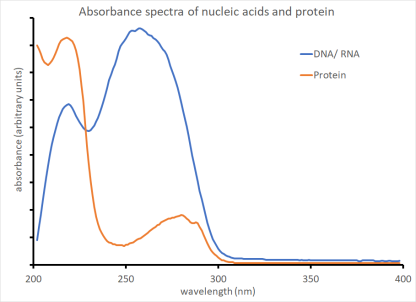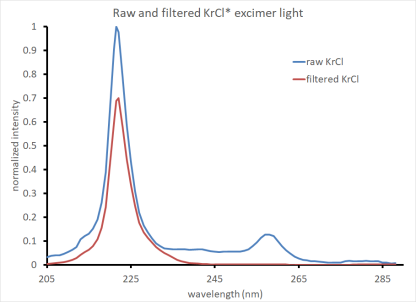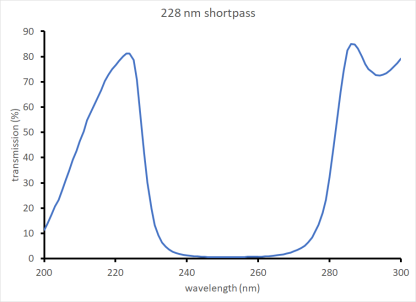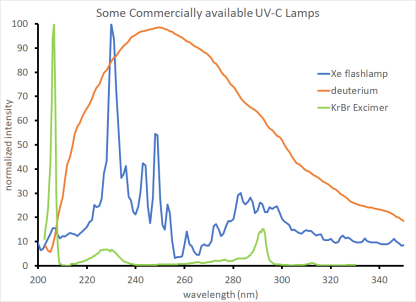Omega Optical specializes in custom filters for your UV sterilization application.
UV sterilization has been used in select applications since the 1950s, starting with water purification. Wherever you get good penetration of the light into the medium, you can perform UV sterilization. These early applications used an unfiltered UV lamp inside an enclosure, but in newer applications where people are present in the space, UV filters are required to protect the occupants. Examples include-
- room sterilization- UV sterilization of hospital rooms, hotel rooms and lobbies
- surfaces- UV sterilization of high-touch surfaces using specialized light fixtures or hand-held devices
- UV disinfection during surgery- UV sterilization of pathogens inside the surgical cavity patient before closing
How does UV sterilization work?
UV light in the 200-300 nm range (UV-C) is absorbed by DNA (and RNA) and proteins present in every living cell. As seen below, the DNA absorbs the most light at about 260 nm and proteins absorb the most light at about 220 nm. Maximal damage occurs at the wavelengths where the most light is absorbed. The light absorbed at these wavelengths breaks (and sometimes makes new) chemical bonds in the DNA (or RNA) and protein. When the DNA (or RNA) is altered, it cannot be replicated and the cells die. Protein damage to viruses can also affect their structural integrity, whereas in a human cell, protein recycling and repair mechanisms clean up most of the damage.

All cells and viruses contain DNA, RNA and protein, but the size of these cells and virus particles vary a lot! Note that in the figure below, there are factors of 10 between each tic-mark. A virus is 100-1000 times smaller than a human, eukaryotic (nucleus-containing) cell!

When are optical filters required for UV sterilization?
Because human cells are damaged by many UV-C wavelengths, the light sources should be filtered whenever people are present in the illuminated area to prevent damage to skin and eyes.
Wavelengths below about 230 nm show minimal damage to human cells, but significant damage to viruses and bacteria. Why? Very little UV-C will reach the nucleus in a human cell.
- UV-C light scatters (or gets deflected from its original path) as it traverses the larger human cell- scattering increases as wavelength decreases.
- Protein absorbs more light at 230 nm than DNA or RNA.
- Light must pass hundreds or thousands of proteins to reach the DNA in the nucleus of a human cell. Most of the light is absorbed before reaching the DNA. In contrast, viruses have only a very thin layer of protein around the DNA or RNA which affords very little protection.
Omega provides custom filters to block light in the 230-300 nm range.
- custom angle-of-incidence (AOI) requirements (read our tech note about AOI effects)
- custom transmission wavelengths based on your lamp's spectral output
- custom blocking requirements
- custom sizes
- production capacity to support OEM quantities
An example- filtered KrCl* excimer lamp

The KrCl* excimer emission spectrum is dominated by a large peak at about 222 nm, but there is also emission up to about 280 nm. Research has shown that light in the 230-300 nm region is damaging to human cells, so Omega designed the following solution to block light in that region. The red curve above shows the KrCl* excimer lamp emission with a filter present.

The KrCl* excimer lamps and filters are being used commercially by Eden Park Illumination in many applications.
One of the first fixtures approved for use in high-traffic hospitality environments is now available from Promethean Hospitality. Read our blog post about the Promethean Flame series of light fixtures!
What other lamps are used for UV sterilization?
As described above, a lamp that makes light in the 200-300 nm range is best for damaging DNA and killing bacteria and viruses. These include deuterium lamps, Xenon flash lamps, KrCl* and KrBr* excimer lamps and others.

These UV lamps have significant emission at wavelengths known to cause skin and eye damage in humans. We are experts at designing filters that block only the wavelengths you need to, given your unique system geometry, instead of using a "one-size-fits-all" approach.
Omega will work with you to provide the wavelength blocking you need for your particular lamp and application.

